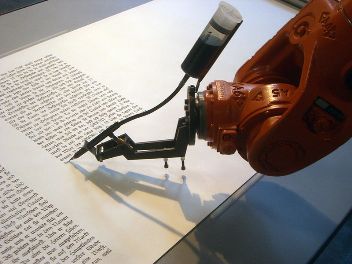Industrial robots
What should you know about industrial robots?
What should you know about industrial robots? Depends on why you are searching for this information. In this article I’ll try to address the most common questions and issues regarding robots used in industrial environment.
Definition
Not every mechatronic device used in industrial environment can be regarded as a robot. As defined by ISO (International Standards Organization) an industrial robot is an automatically controlled, reprogrammable, multipurpose manipulator programmable in three or more axes. You can find this on Wikipedia page on industrial robots.
This is pretty much the accepted definition that is used when talking about industrial robots. However, being a bit of a philosopher by calling I would like to add a few thoughts to it. As you can read on the homepage of this site, the question of what can be regarded as a robot and what can not is not that straightforward. Industrial robotics managed to steer clear of that kind of confusion until recently.
What has changed since mid noughties? People such as ingenious engineers and entrepreneurs are finding more and more ways how robotics can help to optimize workflow in an industrial environment. With advancements in battery technology and wireless networking the long established robotic arms have to pave way to newcomers such as swarm AGVs (Automated Guided Vehicles) used in warehousing. I’m excited to think what new developments we can await! Most of this site still uses the term in the established sense though.
Components

A typical industrial robot consists of a tool, an industrial robotic arm, a control cabinet, a control panel, a teach pendant, as well as some other peripheral equipment. So what is what?
A tool (also called the end effector) is a device designed for a specific task for example – welding or painting. The robot arm, basically, is the thing that moves the tool. Beware! It’s important to understand that not every industrial robot resembles an arm. As I will explain later, there are different types of different robot structures.
A control cabinet resembles robot’s brains. A control panel and a teach pendant makes up the user environment. These parts usually come together.
A control panel is intended to be used by operator to do some routine tasks. For example – changing programs or controlling the peripheral devices. Whereas the teach pendant is usually used only in time of programming, although, it can be left connected to the control cabinet if additional memory is needed to execute a program.
Application
When should you use an industrial robot instead of a human worker?
Ideally, this should be a win-win situation. You know that there are jobs that no one really wants to do. These are those repetitive, tedious jobs that require a lot of monotonous action from the side of a worker, like picking something from one conveyor to another.
If it is always the same task you could use an automated solution tailored specifically for your needs. What if it’s not the case? The situation where a factory needs to be more and more flexible is becoming more and more common. In these cases a re-programmable robot which can be used for different tasks is the right solution.
Also, you should consider a “robot worker” for those tasks that are hazardous for a human worker. For example – surface treatment with dangerous chemicals and work in the environment that is hazardous. In many cases like the ones mentioned it is wiser and cheaper in the long term to use a robot than to hire a worker.
And of course, there are jobs that can’t be done by a human. Like lifting very heavy weights or working in conditions unsuitable for human life. Again, specific automated solutions can be applied in many of these cases. However, if flexibility is required then a robot should be considered.
Here’s a list of most often found robot applications:
- Arc welding
- Assembly
- Coating
- Deburring
- Die Casting
- Moulding
- Material handling
- Picking
- Palletizing
- Packaging
- Painting
- Spot welding
- Transportation, Warehousing
Structures
There are different ways how a robot arm could be constructed. In some cases it doesn’t remind an arm at all. In this article I’ll only list the most common types of robot structures that are used in industrial robotics. I’ll cover each of these types more in depth in my “Types of robots” section.
So there are:
- Cartesian
- Cylindrical
- Spherical
- SCARA
- Articulated arm
- Parallel construction
Why this is important? As you already know (or have guessed) every of these types of construction have their strengths and weaknesses. Some are more precise, some can lift a heavier weight and some are cheaper. This leads me to…
What to consider when choosing a robot? (At least)

What’s the task at hand? Exactly, you should evaluate what will be the task assigned to the robot. This may seem silly at first. You probably already know that you need an arc welding robot for example. However, you may want to consider it more deeply.
Maybe there’s a possibility of expansion? If so, maybe later there could be other or slightly different tasks that could be assigned to the same robot? Maybe the same industrial robotic arm can be used with different tools at different times?
You should consider opportunities like that as it can save you (or your employer) a lot of money.
Technical support. Is a dealer located nearby? Probably you will need to instruct employees, get software updates, warranty maintenance, etc.The dealer should be located as near to you as possible. The farther your robot’s dealer is located, the longer will be your down-time if maintenance is needed and the higher will be the costs of personnel training.
Of course, there could be exceptions. Maybe you have a specific task and the only ones that could provide a robot needed are far away.Otherwise, you should really choose the robot integrator that’s the closest to you.
Your factory. You really shouldn’t forget to check if all needed facilities for a specific robot to operate are present in your plant. Where will you place it? Are all needed connections available at the future robot site? These could include electricity, IOs, Ethernet, Serial etc.
The same thing I mentioned in a task part should also be considered when thinking about technical support and your factory – try to evaluate the future possibilities.
Manufacturers.
Here is a list of most known industrial robot manufacturers:
- ABB
- Adept Technology
- Asyst Technologies
- Brooks automation
- DENSO robotics
- Epson robots
- FANUC robotics
- Intelitek
- Kawasaki heavy industries
- KUKA Robotics
- Yaskawa-Motoman
- Nachi robotic systems
- Reis robotics
- Toshiba Machine
- Stäubli
